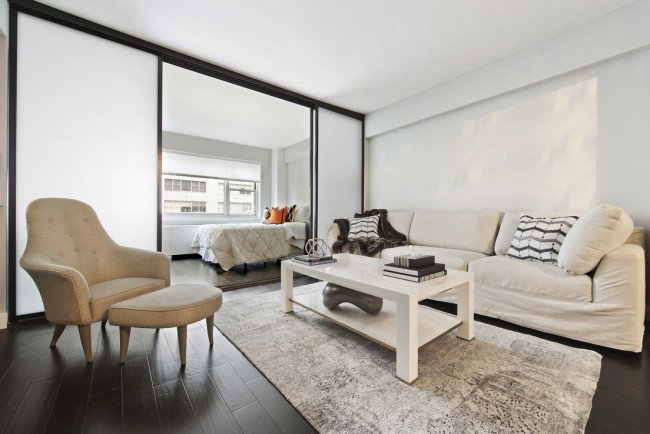
Larger homes are finding larger households, as the housing boom has created bigger homes and the housing bust has strained people’s ability to pay the mortgage. More and more households are multi-generational—up from 4.8 percent to 5.3 percent in the last eight years—or they’re just multi-family households, period. Neighbors are moving in together, married couples are putting off divorce, college kids are returning home, and teen pregnancy is on the rise again after a 14-year decline. Rather than spend $41,275 (the average cost of a modest home addition), temporary walls, partitions, and room dividers can facilitate compacted living arrangements for “residentially distressed” Americans.
Specific Partitions: Sound vs. Sight
Very simple room dividers and wall partitions can create visible barriers in a single home area for minimal cost. If you have basic carpentry skills and tools, a few hundred bucks and a trip to your local hardware store should be enough to construct a temporary wall partition for your home. Conventional use of these barriers include concealment of a bathroom entrance from a public area, separate sleeping spaces for siblings who share a room, or for ornamental purposes such as oriental decor.
If you need a sound barrier within a single area of your home, more advanced skills are likely needed, although hiring a skilled carpenter isn’t going to cost nearly as much as a home addition or renovation contractor. For this partitioning system, some type of door—folding, sliding, pocket—is usually needed. To retain a line of sight, glass doors can be used for monitoring children or to create a more spacious feel for a small, partitioned area. To increase versatility, basic curtains or shades will give you both options.
Soundproof Glass
Standard doors with high-quality jambs and weatherstripping can generally provide enough peace and quiet for two people to co-exist in adjacent rooms, but if somebody plays an instrument, cranks their stereo system, or is easily needled by extraneous noises, soundproof glass may be necessary. To help match your desired level of soundproofing and the doors you buy, take a look at the Sound Transmission Class (STC) rating. As a logarithmic scale, a small increase in a door’s rating can make a big difference. A jump from a 28 STC rating (typical glass window) to a 43 STC rating (basic soundproof glass) represents an increase in noise reduction of more than 95 percent. Comparatively, most residential walls have a rating between 42-43, while high-end soundproofing systems can have a rating of 55 or more.
vAdditional Design Elements
Try to balance aesthetics and versatility so your room divider isn’t an eyesore or shoddily constructed but does allow for the greatest number of alterations, looks, and configurations. Adding a functional element to a wall partition is another way to add versatility. Carpenters can custom-build a room divider to double as a bookcase, closet storage, full-length mirror, or any other number of nifty furnishings. Keep in mind, too, that with an economic recovery, many homes will benefit from the eventual removal of these wall partitions. Thus, most wall partitions can and should be designed for a seamless removal that won’t leave visible scars of its construction.
Duplexes: House Dividers
A more comprehensive, though permanent, way to accommodate larger, multi-faceted households is by converting the house into a duplex. If you have two full bathrooms and multiple bedrooms on opposite sides or floors of your home, this conversion might be a relatively simple process, although any external construction will almost surely entail securing a zoning permit. Some municipalities may be reluctant to grant such a permit, if they’re trying to control certain demographics. In college towns, for example, such a zoning/building permit might be denied to protect long-term residents from an influx of college students.
Yet, if you have the need and the opportunity, this renovation can make a ton of sense. Even moderately complex conversions costing $10,000 or more might be worth it, if it’s the only way to logistically accommodate a second family, household, and income base for your property. Should your living arrangements change down the road, rather than converting the duplex back into a single-family home, you might consider renting out the other half of the duplex or turn the entire house into an investment property, especially if your neighborhood has the demand for such rental properties.
 Add Custom Beauty to Your Home with Blown Glass
Add Custom Beauty to Your Home with Blown Glass  The Dish on Dining Room Decorating
The Dish on Dining Room Decorating  Focus Factors: Hanging Framed Art and Picture Lighting
Focus Factors: Hanging Framed Art and Picture Lighting  The 5 Benefits of Working With an Interior Designer
The 5 Benefits of Working With an Interior Designer  How to Create a Meditation Room in 7 Steps
How to Create a Meditation Room in 7 Steps 

Are You Familiar With This Topic? Share Your Experience.